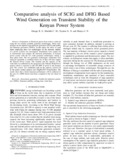| dc.contributor.author | Orenge, R. S. | |
| dc.contributor.author | Muriithi, Christopher M. | |
| dc.contributor.author | Nyakoe., G.N. | |
| dc.contributor.author | Muisyo, I. N. | |
| dc.date.accessioned | 2017-09-08T10:06:54Z | |
| dc.date.available | 2017-09-08T10:06:54Z | |
| dc.date.issued | 2014 | |
| dc.identifier.citation | Proceedings of 2014 International Conference on Sustainable Research and Innovation, Volume 5, 7th-9th May 2014 | en_US |
| dc.identifier.uri | http://hdl.handle.net/123456789/2821 | |
| dc.description.abstract | Generation of Electrical power from wind is achieved using the two mainly available generator technologies. These technologies are the squirrel cage induction generators (SCIG) and doubly fed induction generators (DFIGs). In this paper, the effect of wind farms employing these two technologies on the transient stability of a power systems was investigated. Simulations were carried out to demonstrate and compare the transient performance of Kenyan power system with the two wind generator technologies during a three phase fault. The two generator technologies mentioned were analyzed separately to establish which one of them will least impact the Kenyan Power system. The location and the capacity of the wind farm was informed by the proposed Lake Turkana Wind Power project which is expected to add 300 MW of power to the Kenyan grid. The system was established and all the analysis carried out
In the power system analysis tool DIgSILENT PowerFactory. The results show that a better transient performance will be achieved in the case of a DFIG based wind farm, compared to the one based on SCIG.
— | en_US |
| dc.language.iso | en | en_US |
| dc.subject | Syncronous generators, | en_US |
| dc.subject | Doubly-fed induction generators (DFIG), | en_US |
| dc.subject | Transient stability, | en_US |
| dc.subject | Wind farm, | en_US |
| dc.title | Comparative analysis of SCIG and DFIG based wind generation on transient stability of the Kenyan power system | en_US |
| dc.type | Technical Report | en_US |

